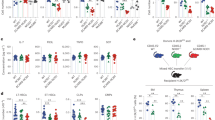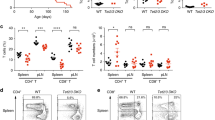Abstract
The transcriptional repressor Gfi1 is a nuclear zinc-finger protein expressed in T-cell precursors in the thymus and in activated mature T lymphocytes1,2,3,4. Previous experiments have shown that Gfi1 is involved in T-cell lymphomagenesis and in the development of T-cell progenitors5,6,7. Here we show that Gfi1 is also expressed outside the lymphoid system in granulocytes and activated macrophages, cells that mediate innate immunity (that is, non-specific immunity). We have generated Gfi1-deficient mice (Gfi1−/−) and show that these animals are severely neutropenic and accumulate immature monocytic cells in blood and bone marrow. Their myeloid precursor cells are unable to differentiate into granulocytes upon stimulation with granulocyte colony–stimulating factor (G-CSF) but can develop into mature macrophages. We found that Gfi1−/− macrophages produce enhanced levels of inflammatory cytokines, such as tumor necrosis factor (TNF), interleukin-10 (IL-10) and IL-1β, when stimulated with bacterial lipopolysaccharide (LPS) and that Gfi1−/− mice succumb to low doses of this endotoxin that are tolerated by wildtype mice. We conclude that Gfi1 influences the differentiation of myeloid precursors into granulocytes or monocytes and acts in limiting the inflammatory immune response.
This is a preview of subscription content, access via your institution
Access options
Subscribe to this journal
Receive 12 print issues and online access
$209.00 per year
only $17.42 per issue
Buy this article
- Purchase on Springer Link
- Instant access to full article PDF
Prices may be subject to local taxes which are calculated during checkout




Similar content being viewed by others
References
Gilks, C.B., Bear, S.E, Grimes, H.L. & Tsichlis, P.N. Progression of interleukin-2 (Il-2)-dependent rat T cell lymphoma lines to IL-2-independent growth following activation of a gene (Gfi1) encoding a novel zinc finger protein. Mol. Cell Biol. 13, 1759–1768 (1993).
Zweidler-Mckay, P.A., Grimes, H.L., Flubacher, M.M. & Tsichlis, P.N. Gfi1 encodes a nuclear zinc finger protein that binds DNA and functions as a transcriptional repressor. Mol. Cell. Biol. 16, 4024–4034 (1996).
Schmidt, T., Karsunky, H., Rödel, B., Zevnik, B., Elsässer, H.P. & Möröy, T. Evidence implicating Gfi1 and Pim-1 in pre-T-cell differentiation steps associated with β selection. EMBO J. 17, 5349–5359 (1998).
Rödel, B. et al. The zinc finger protein Gfi-1 can enhance STAT3 signaling by interacting with the STAT3 inhibitor PIAS3. EMBO J. 19, 5845–5855 (2000).
Scheijen, B., Jonkers, J., Acton, D. & Berns, A. Characterization of Pal-1, a common proviral insertion site in murine leukemia virus-induced lymphomas of c- Myc and Pim-1 transgenic mice. J. Virol. 71, 9–16 (1997).
Schmidt, T., Karsunky, H., Gau, E., Zevnik, B., Elsässer, H.P. & Möröy, T. Zinc finger protein GFI1 has low oncogenic potential but cooperates strongly with pim and myc genes in T-cell lymphomagenesis. Oncogene 17, 2661–2667 (1998).
Zörnig, M., Schmidt, T., Karsunky, H., Grzeschiczek, A. & Möröy, T. Zinc finger protein GFI1 cooperates with Myc and Pim-1 in T-cell lymphomagenesis by reducing the requirements for IL-2. Oncogene 12, 1789–1801 (1996).
Lagasse, E. & Weissman, I.L. Flow cytometric identification of murine neutrophils and monocytes. J. Immunol. Meth. 197, 139–150 (1996).
Mombaerts, P. et al. RAG1-deficient mice have no mature B and T lymphocytes. Cell 68, 869–877 (1992).
Akashi, K., Traver, D., Miyamoto, T. & Weissman, I.L. A clonogenic common myeloid progenitor that gives rise to all myeloid lineages. Nature 404, 193–197 (2000).
Takeda, K. et al. Enhanced TH1 activity and development of chronic enterocolitis in mice devoid of STAT3 in macrophages and neutrophils. Immunity 10, 39–49 (1999).
Napirei, M., Karsunky, H., Zevnik, B., Stephan, H., Mannherz, H.G., & Möröy, T. Features of systemic lupus erythematosus in DNase1-deficient mice. Nature Genet. 25, 177–181 (2000).
Acknowledgements
We thank P. Ferrier, Marseille, for the pPNT vector and Rag1-deficient mice, and A. Nagy, Toronto, for R1 ES cells. We are indebted to I. Spratte, W. Wegrzyn and E. Gau for excellent technical assistance, K. Lennartz for FACS assistance and P. Plessow and T. Civela for animal care. This work was supported by the Deutsche Forschungsgemeinschaft, DFG, the Fonds der chemischen Industrie, the European Community Framework 5 Program and the IFORES Program of the University of Essen Medical School.
Author information
Authors and Affiliations
Corresponding author
Rights and permissions
About this article
Cite this article
Karsunky, H., Zeng, H., Schmidt, T. et al. Inflammatory reactions and severe neutropenia in mice lacking the transcriptional repressor Gfi1. Nat Genet 30, 295–300 (2002). https://doi.org/10.1038/ng831
Received:
Accepted:
Published:
Issue Date:
DOI: https://doi.org/10.1038/ng831
This article is cited by
-
HMG20B stabilizes association of LSD1 with GFI1 on chromatin to confer transcription repression and leukemia cell differentiation block
Oncogene (2022)
-
Identification of GFI1 mutations in adult patients with congenital neutropenia
Annals of Hematology (2022)
-
GFI1 tethers the NuRD complex to open and transcriptionally active chromatin in myeloid progenitors
Communications Biology (2021)
-
LSD1-mediated repression of GFI1 super-enhancer plays an essential role in erythroleukemia
Leukemia (2020)
-
Mouse models of neutropenia reveal progenitor-stage-specific defects
Nature (2020)



